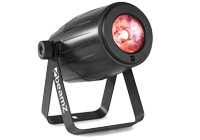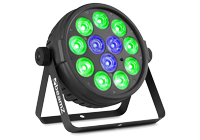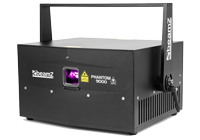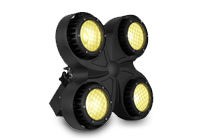What is theatre lighting used for?
There are multiple types of lighting in theatres available in this category, including some of our high-end range of BeamZ professional lasers, spotlights, fresnel spots and stage blinders. All of these fixtures are ideal for beginning your lighting setup and can also be easily integrated into your pre-existing lighting rig. With DMX programming capabilities, you can set the lights to perform at specific sections of your play to sync up with the scenes.
Stage blinders produce an extremely bright flash of light from their COB-LEDs for various applications. These 2-in-1 fixtures can also be used as a strobe effect in order to produce bumps during the performance, where the sudden, blaring light prevents the audience from seeing scene changes and emulates slow-motion. With the blinders able to be used in a wall or line arrangement that faces the audience, they are most commonly used to encourage applause and allow the actors to see their crowd.
Our range of spotlights varies between moving head, follow and fresnel spots. They are an industry-standard of theatre lighting, where their narrow beam angle highlights a specific object or person to focus the audience’s attention to the point of interest. Follow spots do exactly as stated, where an attendant operator usually moves it manually to focus on the actor.
Moving heads, however, are completely programmable via DMX, allowing 16-bit adjustments to pan and tilt movement in almost every direction for flawless scanning of the stage and room. With motorized focus, they can project gobos onto surfaces for interesting pattern effects that are produced in great detail over long and short distances.
Fresnel spotlights feature a ridged lens that produces a high-intensity beam of light with soft edges and a large throw distance. Some of these fresnel lights are fitted with hinged 'barn doors' that can be adjusted to shape the beam and reduce the glare so that performers won’t be distracted.
Different types of lighting in theatre
Also available in this category are wash lights, which are most commonly used for background lighting or for illuminating the entire space in vibrant colours. Most of these fixtures are used as stage floor lights to light up the backdrop and flat scenery. With a wide and powerful output, they can fill the room with colourful lights to set the atmosphere of the scene. Some even have a hanging bracket to install them on truss to flood the stage with various colours.
Gobo projections are available on various lights, such as moving heads, spots and even lasers. These are designs etched onto rotating discs that can be projected onto surfaces to show different elements, such as foliage and skylines. Some are interchangeable in order to use your own patterns during the play.
Alternatively, you can create your own patterns and texts to display during the performance using ILDA programming on high-end lasers. This is a digital programming software on computers that lets you design different images that will be produced by the laser. This programming option is similar to DMX, but is best suited for single lasers as it has a better signal strength and analog modulation.
DMX is the best option for using multiple lights all at once, as you can program a synchronised display across truss mounted and stage floor lights. Through DMX, you can adjust each light individually for flawless light fades and dimming, strobe and panning movement (for moving head lights). This allows you to programme lights to compliment the atmosphere and action of your stage show, with the ability to create scenery and backdrops to match every scene.
Theatre Lighting Effectiveness
Lighting plays a crucial role in theatrical productions, significantly influencing the mood, atmosphere, and visual impact of a performance. It serves as an essential tool for directors and designers to convey emotions, highlight important aspects of the scene, and guide the audience's focus.
One of the primary functions of theatre lighting is to set the mood of a scene. Different lighting techniques and colours can evoke various emotions and create distinct atmospheres. For example, warm tones might be used to create a cosy, intimate setting, while cool blues and harsh whites can depict a sense of coldness or tension. By carefully selecting and adjusting lighting, designers can subtly influence how the audience perceives and reacts to a scene.
In addition to setting the mood, lighting plays a vital role in shaping the imagery on stage. It can be used to define spaces, create depth, and enhance the visual composition of a scene. Through techniques such as spotlighting, backlighting, and shadow play, lighting designers can craft visually striking images that support the narrative and artistic vision of the production. For instance, a silhouette effect might be employed to create mystery, while bright, even lighting can make the stage appear more open and inviting.
Highlighting key moments and performers is another critical aspect of theatre lighting. By directing light to specific areas or individuals, designers can draw the audience's attention to important actions or characters. This technique is often used during pivotal scenes or to emphasise a significant gesture or expression. Spotlights, in particular, are effective for singling out performers and ensuring that their movements and expressions are clearly visible to the audience.
LED Lights for Theatre Applications
One of the primary benefits of using LED lights for theatre applications is their detailed colour mixing capabilities. LED lights, such as spotlights and wash bars, allow for precise control over colour combinations, enabling designers to achieve an extensive palette of hues. This capability is particularly useful in theatrical settings, where subtle colour shifts can dramatically change the mood and atmosphere of a scene. With LED lights, designers can smoothly transition between colours and create complex lighting effects that support the narrative and visual aesthetics of a production.
The longevity of LED lights is another significant advantage. Compared to traditional incandescent bulbs, LEDs have a much longer lifespan, reducing the frequency of replacements and maintenance. This durability translates to cost savings over time and ensures that the lighting setup remains reliable throughout extended runs of a show.
LED lights are also known for their lack of noise, which is crucial in a theatre environment where quiet operation is essential. Unlike older lighting technologies that may produce a humming or buzzing sound, LEDs operate silently. This feature helps maintain the integrity of the performance, ensuring that the audience's attention remains focused on the actors and the action on stage rather than being distracted by unwanted noise.
DMX control is another notable benefit of LED lights. This digital control protocol allows for precise and flexible management of lighting effects, enabling designers to program intricate lighting sequences and synchronise them with other elements of the production, such as sound and special effects.
LED spotlights provide focused beams of light that can highlight individual performers or specific areas of the stage, creating sharp contrasts and drawing the audience's attention. Wash bars are excellent for covering large areas with even, diffused light, making them ideal for background illumination and colour washes.
Theatre Spotlights for Storytelling
Theatre spotlights play a crucial role in storytelling, helping to direct the audience's attention and emphasising key moments. Their precise beams of light are essential tools for lighting designers, allowing them to highlight specific actors, props, or areas of the stage, thereby guiding the visual narrative.
One of the primary functions of spotlights in theatre is to single out performers. By illuminating a particular actor or group of actors, spotlights ensure that the audience's focus remains on the central action or dialogue. This is especially important during solos, monologues, or pivotal scenes where the character's expressions and movements need to be clearly visible. The ability to control the intensity and size of the spotlight beam allows designers to create intimate moments that draw the audience in, making the performance more engaging and emotionally impactful.
In addition to highlighting performers, spotlights are used to underscore dramatic moments and transitions. For instance, a sudden spotlight can signify a significant shift in the story, such as the introduction of a new character or a crucial revelation. This use of lighting cues helps to underscore the narrative and provides visual punctuation that enhances the storytelling process.
Spotlights also contribute to the overall composition of the stage, adding depth and dimension to the visual presentation. By strategically placing spotlights, designers can create patterns of light and shadow that enhance the mood and atmosphere of the scene. For example, a tightly focused spotlight can create a sense of isolation or spotlight a character's inner turmoil, while a broader beam can suggest openness and freedom.
Moreover, spotlights are often used in conjunction with other lighting effects to build a cohesive visual narrative. They can be layered with wash lights, footlights, and backlighting to create a rich, textured lighting design that supports the performance.












